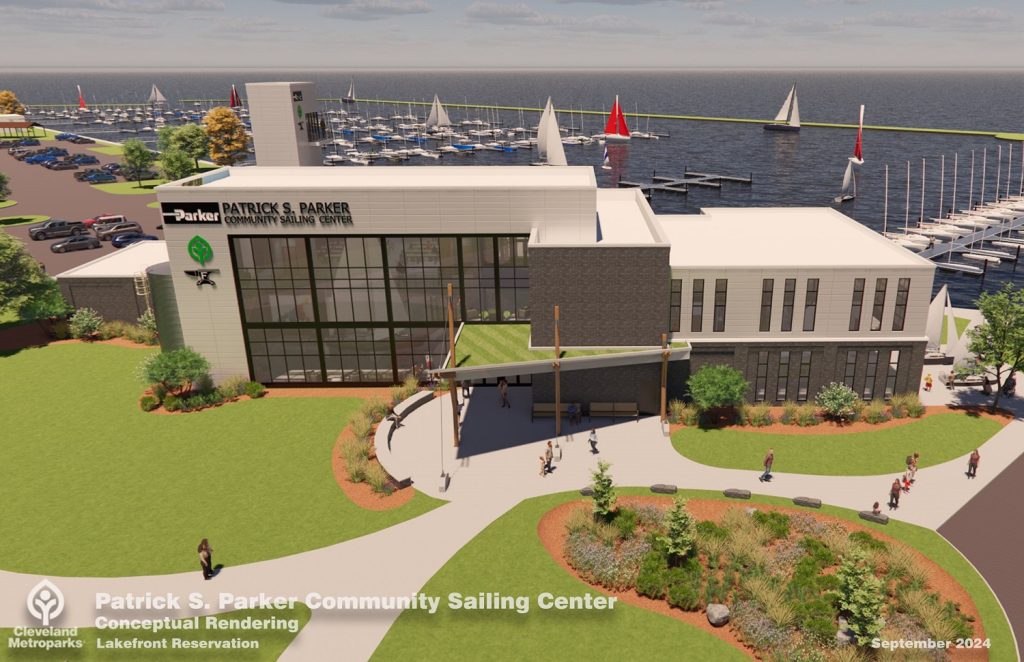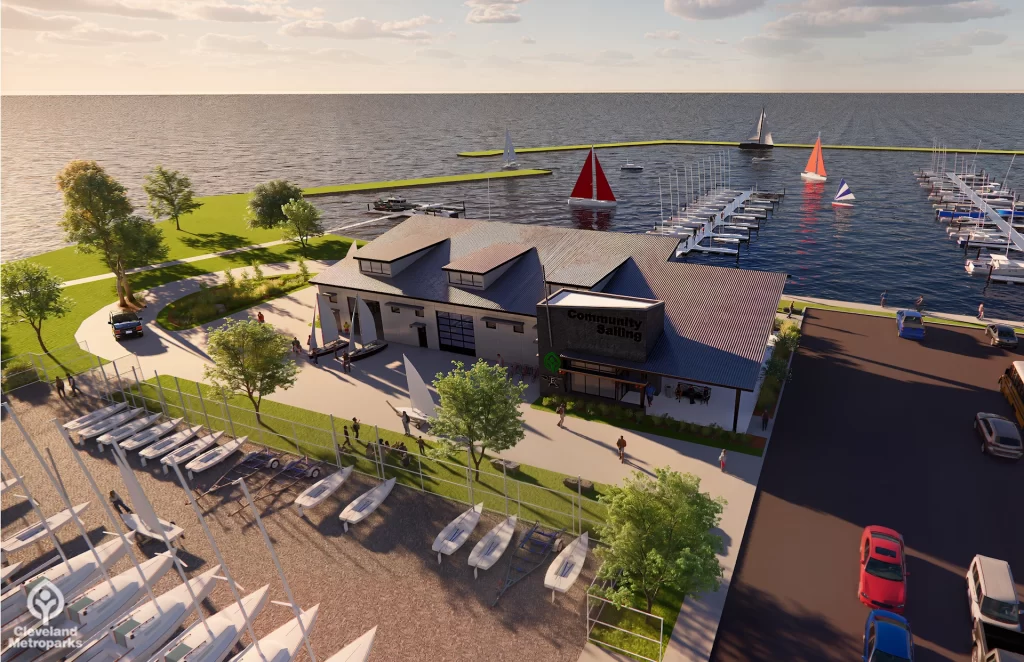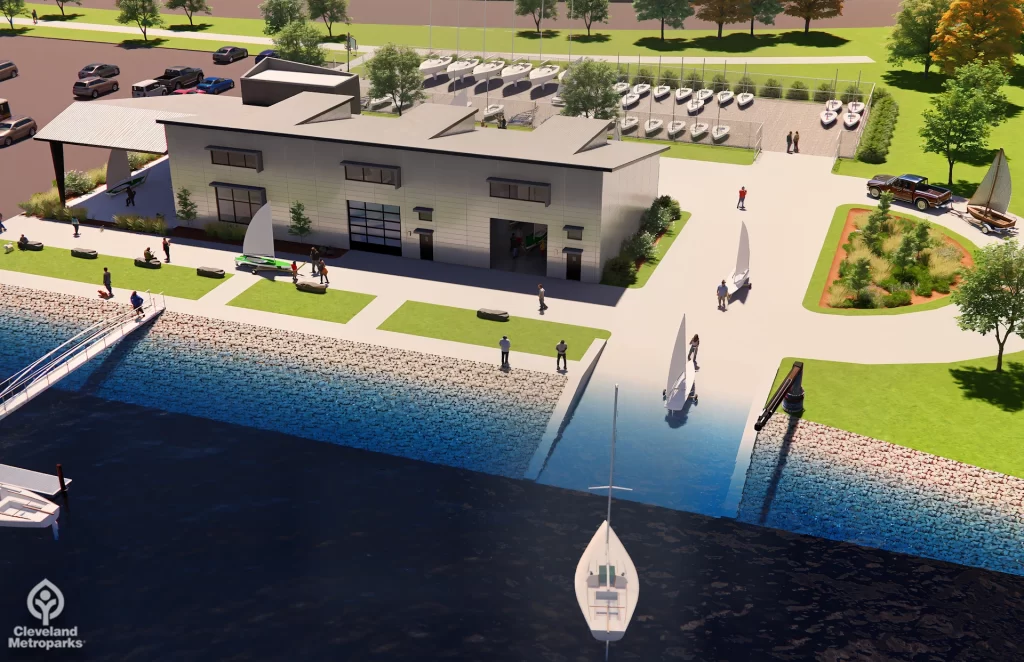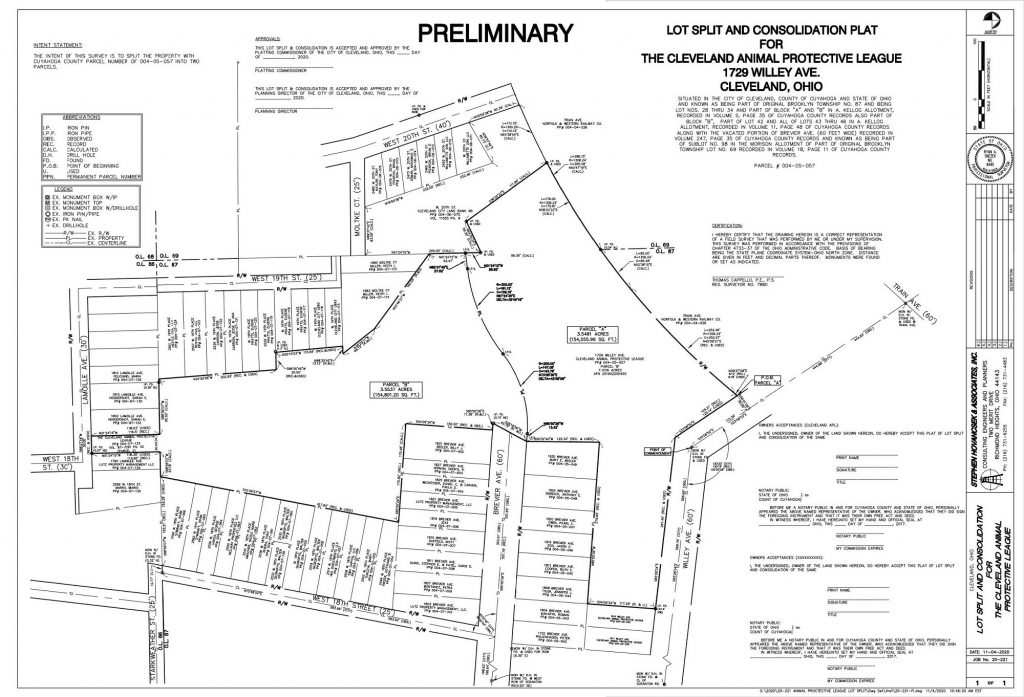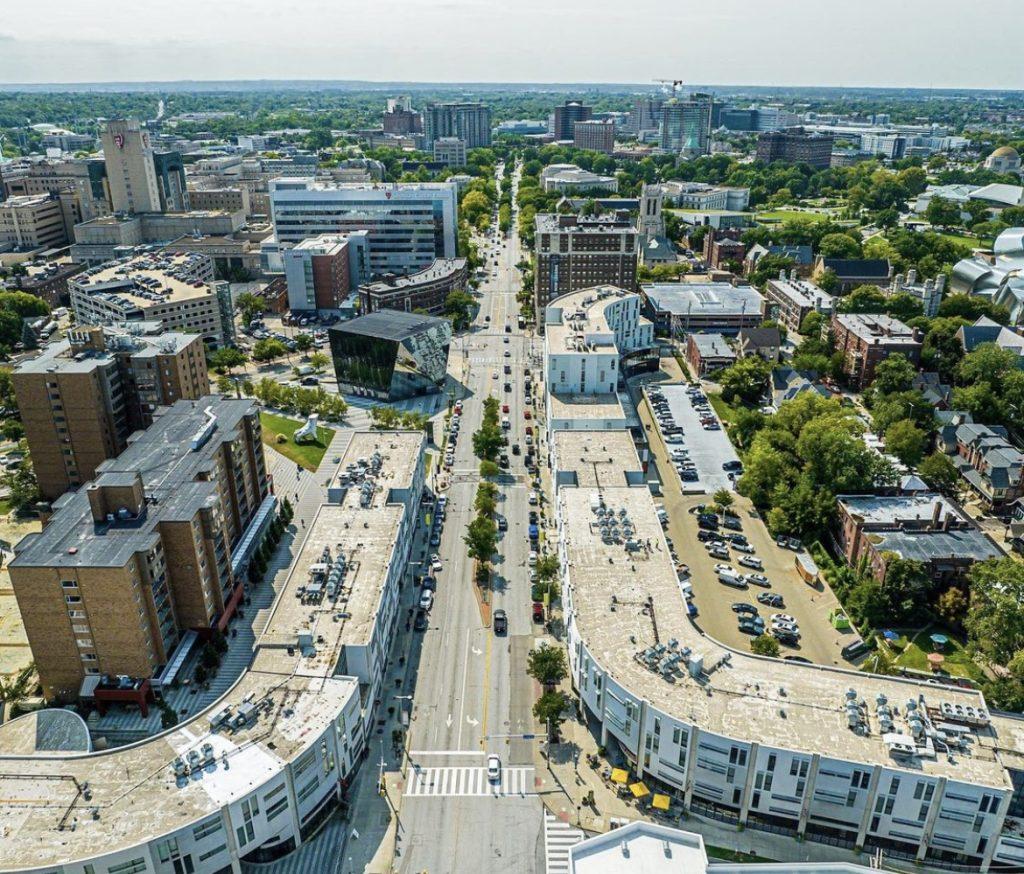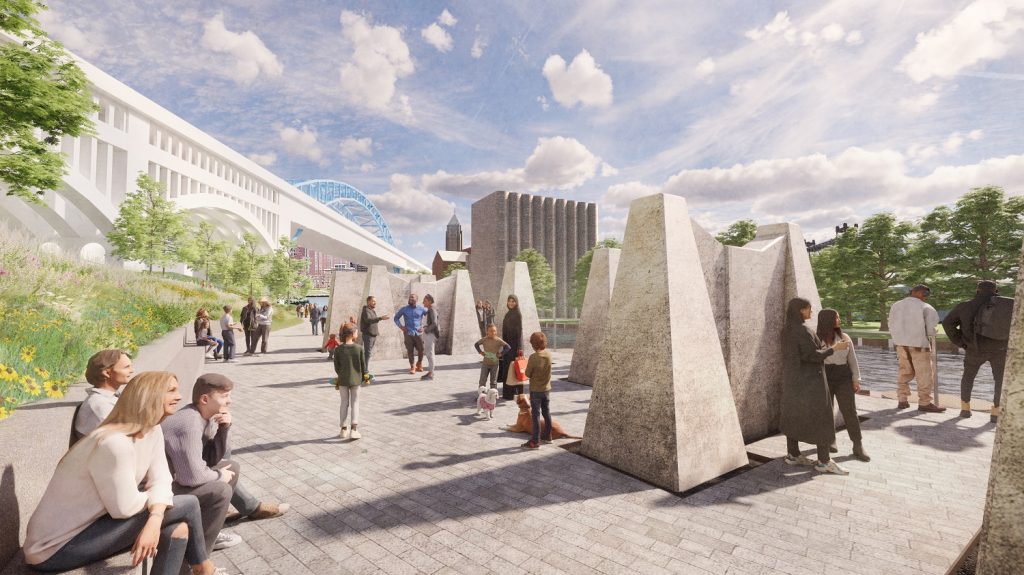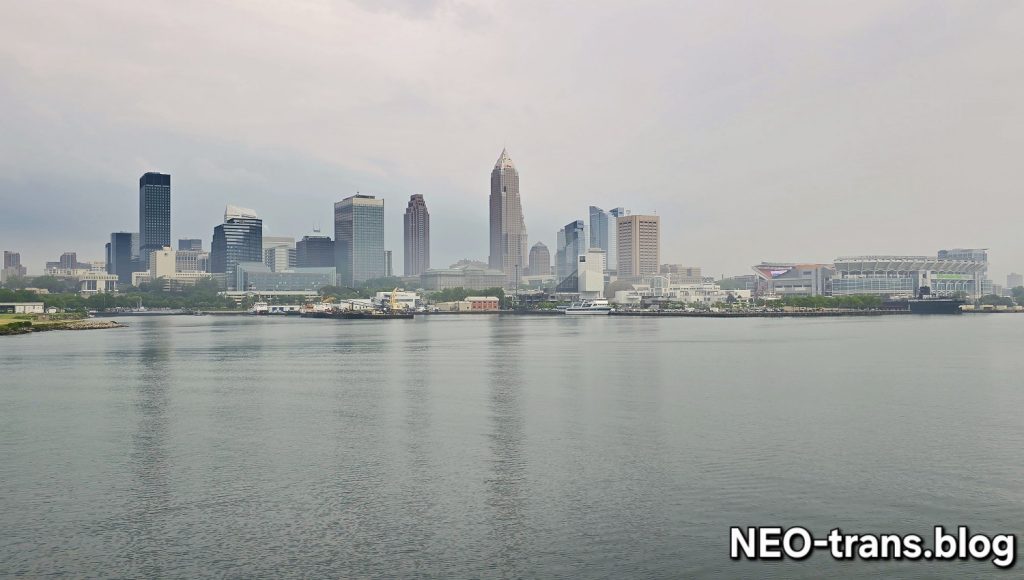
The lakefront east of downtown and the harbor north of it are all connected to the Port’s Cleveland Harbor Eastern Embayment Resilience Strategy (CHEERS). Dredging of the harbor to keep it open for shipping is deposited at the northeast corner of Burke Lakefront Airport, seen at left. A dredging barge is visible just left of center (NEOtrans). CLICK IMAGES TO ENLARGE THEM.
Port also awards $260,000 in community grants
With federal permitting dragging on to allow the Port of Cleveland to build on offshore island east of downtown, the Port board yesterday awarded a $4 million contract so the port could continue to deposit sediment from the Cleveland harbor and Cuyahoga River at the northeast corner of Burke Lakefront Airport until 2029.
The new island and reshaped shoreline, part of the Cleveland Harbor Eastern Embayment Resilience Strategy (CHEERS), is intended to add more recreational waterfront opportunities for residents. The project is a partnership with the Cleveland Metroparks, city of Cleveland and others. It is hoped federal permits can be secured well before the extended contract expires in 2029.
The new island and shoreline will be constructed from repurposed sediment dredged from the harbor and Cuyahoga River. Not only will it expand public access to Lake Erie, but it will protect infrastructure including Interstate 90 from wave action from rising lake waters. Unfortunately, it is taking longer than expected to get the permits approved by the U.S. Army Corps of Engineers.
So the contract was awarded to Mark Haynes Construction, Inc. of Norwalk, OH to extend the life of the Port’s current dredge repository. The Port funding is expected to be paid back over time through tipping fees to dredging contractors, which are under contract with the Corps of Engineers.
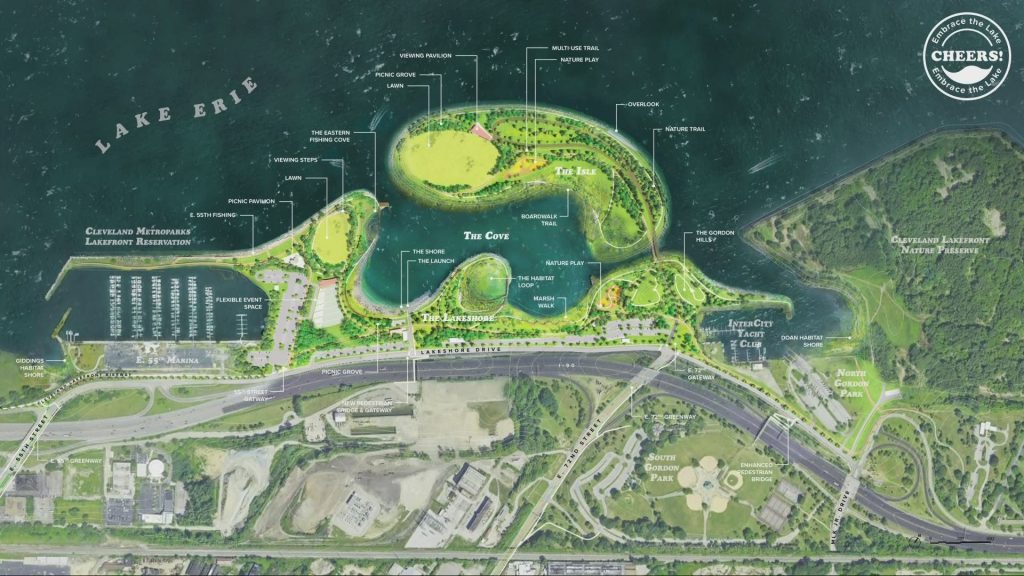
The Cleveland Harbor Eastern Embayment Resilience Strategy (CHEERS) masterplan was created in 2021. But getting federal permitting for major projects like this often takes a long time. So the Port of Cleveland is taking some interim steps to handle its harbor and river sediment dredge deposits (Metroparks).
“This will buy us time until CHEERS is permitted and that area is ready to accept dredged sediment,” said Matt Wenham, chief of engineering and capital development at the Port, in a written statement.
The Port’s Sediment Processing and Management Facility is the only facility permitted by the Corps to receive the 250,000 cubic yards of sediment dredged each year from the harbor and navigable portion of the Cuyahoga River, an action which keeps shipping lanes open. At the facility, the Port beneficially harvests and recycles much of the dredge material.
In the meantime, the Cleveland Metroparks is making improvements to the CHEERS area around Gordon Park and the East 55th Street Marina. Construction began in May on the $18.5 million Patrick S. Parker Community Sailing Center plus the Jack, Joseph and Morton Mandel Boathouse is expected to be completed in 2026.
Additionally, the Port of Cleveland board of directors yesterday approved the allocation of $260,000 in Community Investment Fund (CIF) grants to help support seven local organizations advancing education, historic preservation and maritime access across the community.
“These awards reflect our deep commitment to investing in people and places that shape a stronger, more inclusive future for our region,” said David Gutheil, interim CEO of the Port of Cleveland. “Each selected project aligns with the Port’s mission to drive economic vitality while strengthening the communities we serve.”
Established in 2018, the CIF sets aside 10 percent of Port development finance revenues annually to support nonprofit-led initiatives that align with the Port’s values – especially around workforce readiness, sustainability, and equitable development. To date, the fund has invested over $500,000 in community grants to community-based organizations throughout Cuyahoga County.
The Port issued a Notice of Funding Opportunity on May 15 and said it received 17 qualified proposals. Following an evaluation of the proposals, a CIF committee has recommended funding seven initiatives by seven different organizations.
Teaching Cleveland won $50,000 for its support of the refinement of our Fresh Water Institute (FWI) Year One experience, as well as the onboarding and engagement of a new cohort of students.
FWI is an interdisciplinary, two-year program designed for Northeast Ohio area high school students to delve into the critical importance of Lake Erie and the Great Lakes to our region. Through summer field research and capstone projects, fellows will develop a comprehensive understanding of the water cycle, its impact on our communities, and the complex environmental and social issues surrounding this essential resource.
The Great Lakes Science Center was awarded $50,000 to support maritime-focused programming and operational activities for the Centennial Celebration of the Steamship William G. Mather including mobile maritime outreach and interactive Great Lakes history exhibits.
The Cleveland Restoration Society got $50,000 to recapitalize its Historic Properties Fund to enable strategic investments in Cleveland properties it currently owns or might own in the near future.
These properties include eight houses on Newton Avenue (Hough neighborhood), the Dall-Mays Houses on East 46th Street (Central neighborhood), and the Jesse Owens Family Home on East 100th Street (Fairfax neighborhood). Investments in these properties would be transformational for the subject property and for the surrounding area.
The port awarded $35,000 to the Cleveland Rowing Foundation so it can hire a Row Cleveland community engagement coach focused on expanding rowing and river access to underserved neighborhoods.
Baldwin Wallace University won $30,000 to fund the “Mobile Wave Tank for Marine Technology Outreach” to design and build a demonstration scale (approximately two-meter length) wave tank for education and outreach. The key applications of this project will focus on ocean exploration, aquaculture, marine transportation and desalination (alternative fuels).
Economic & Community Development Institute, based in Cleveland’s Midtown neighborhood, received $25,000 so it can support training and resources for entrepreneurs and small businesses.
Lastly, the RevLove Urban Farm of Cleveland, formerly called Elements of Internal Movement, got $20,000 to fund community outreach coordinators and educators to assist with programming that hires youth through funding provided by Ohio Means Jobs for a structured, hyper-localized, experiential internship experience.
END

